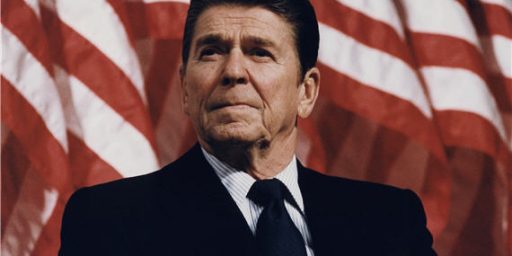Reagan’s Last Decade
Evan Thomas and Eleanor Clift have a touching feature in Newsweek detailing President Reagan’s final years and, especially, Mrs. Reagan’s painful task.
The news did not surprise her. A decade ago, Nancy Reagan took her beloved Ronnie to the Mayo Clinic. The former president, her soulmate of more than 40 years, had been forgetting things, repeating himself, trying but failing to do the simplest things. When the doctors returned with their devastating verdict—Alzheimer’s, then a relatively new term—Nancy was already braced for the worst. “By the time you go in to get checked out,” a source close to the Reagan family told NEWSWEEK, “something has given you the idea that there is something very wrong.” Discovering what the enemy was, though, did not make the toll the disease would take any easier to bear. In 1994, “nobody knew what to expect,” the family insider recalled. “We didn’t know what questions to ask, what to talk about, what the future would be like.” Mrs. Reagan did know one thing: the man who called her his “roommate” and wrote her softly sentimental love letters in their fifth decade of marriage was going to leave her—slowly, painfully, bit by bit.
And so began what Nancy called her husband’s “long goodbye,” which was, for her, 10 years of exacting caregiving, hurried lunches with friends, ever-briefer phone calls to the outside world, hours spent with old love letters and powerful advocacy for new research into cures for the disease that was taking Ronnie from her.
Through the long years after the diagnosis, she never wavered. She stood by him, rarely leaving his side for more than an hour or two. The story of her devotion over the last decade is in a way grim and unrelieved, but also tender and loving. The woman once mocked as a Lady Who Lunched showed more true grit than any cowboy Ronald Reagan ever played.
The whole piece is worth a read.
Hugh Sidey recounts “The Gipper’s Final Flight” in Time.
The sinking California sun turned soft red and a breeze ruffled the hillside when Ronald Reagan was laid to rest on the magnificent stage created for his last bow. As the final taps floated out over the shimmering Pacific Ocean, Nancy Reagan held the flag from his casket close to her. She was worn but still resolute from the long week of farewell.
His body had ridden the dark caisson up to the U.S. Capitol Rotunda in Washington, and the riderless horse, with Reagan’s boots turned backward in the stirrups, had walked behind it. Tens of thousands of people queued up there to give their salutes and mumbled little tributes to this man they thought of as a neighbor. The Washington National Cathedral was filled with the world’s power fraternity, including President George W. Bush and all the living former Presidents—Bill Clinton, George H.W. Bush, Jimmy Carter, Jerry Ford—and some who had tried but failed—Al Gore, Bob Dole, Walter Mondale. After the service, Reagan’s casket was clamped to the floor in the back of a plane that is used as Air Force One, and he began his journey home with family, old friends and staff.
The travelers came back to the casket alone or in clusters to stand for a moment beside the man they had followed and worshipped. They reached out to touch the flag, and they wept, but they were not broken people. More often than not they whispered their undimmed gratitude. “Thank God I knew him. He changed my life.”
Merv Griffin, one of the honorary pallbearers, beamed his persistent humor at former Prime Minister Margaret Thatcher, telling how he had gone to London’s Berkeley Square in search of the nightingales made famous in a song, A Nightingale Sang in Berkeley Square. “But I only found pigeons,” he said, chuckling. The very game Thatcher had arrived on board with the formidable hat she wore in Washington stowed in a sturdy box where it would remain for the rest of this journey of tribute, which she insisted on making despite a series of small strokes that had restricted her public life. An examination of the guest book from Blair House, where Nancy stayed last week, showed that Thatcher’s touch for brevity and devotion was still intact, though she did not have the strength to talk in the cathedral and had them play her recorded speech. “To Ronnie,” she wrote. “Well done, thou good and faithful servant.”
Nancy spent some of her time watching a replay of the cathedral service on a giant TV screen and reading letters of condolence from famous friends like Billy Graham and Queen Elizabeth. At one point Nancy and the children, filled with their sense of loss but not muted by it, gathered around the casket and seemed to reflect Reagan’s own advice to look to the future. They talked of son Ron’s television career and Patti’s writing.
The streaking 747 was so far ahead of schedule that a swing over Tampico, Ill., Reagan’s birthplace, was wedged into the flight plan. The pilot dipped the plane’s wings, and Nancy called out, “Quick, get Ron and Patti to take a look.” They gazed silently out the windows. The tiny cluster of buildings on a land-sea of vivid green summer corn quickly slid beyond view. “A lot of corn,” said Nancy. Mike Deaver, who had served Reagan so loyally, wore the cuff links that he had given Reagan on his 75th birthday. Nancy had recently returned them. Deaver wore them for the first time on this flight. “I don’t think I will wear them again,” he said quietly.
The riding boots used in the procession were being taken back home. The travelers reverently hefted them, explored the soles. The boots were made by the Dehner Co., of Omaha, and their style was explained by young Ron. “These are English riding boots. Dad also used an English saddle, which pushed him forward, and he clamped the horse between his legs.” The boots had been washed but expressly not polished for their journey through Washington streets. Spots of wear showed on the leather, which was buckled around the rider’s legs.
So many old Reagan stories were told, so many laughs remembered, that the flight seemed far too short. The plane eased down into Simi Valley in a salute to the thousands waiting beside the highways to see Reagan come home. Flashes from the cameras of the people clustered below could be seen from the plane, a ritual of reaching out to one of their own who had climbed to the world stage and become a great star beyond the imaginations of even these California dreamers.
Update: New York Post has an interesting profile on MG Galen Jackman, who escorted Mrs. Reagan all week. Military Escort A Pillar Of Strength
He’s been Nancy Reagan’s ramrod-straight escort during the weeklong farewell to her husband.
As onetime director of operations for the U.S. Southern Command, Maj. Gen. Galen Jackman fought narco-terrorists in South America and oversaw U.S. Army training camps for Colombian counter-narcotics brigades.
Until last year, he was in charge of overseeing joint operations in Latin America and the Caribbean, and supervised military support to Colombian troops as well as military ops at Guantanamo Naval Base and Haiti, a spokesman for the U.S. Southern Command told The Post.
As current commander of the U.S. Military District of Washington, the native Nebraskan’s duties now include overseeing ceremonies in the nation’s capital with high-ranking personnel and visiting heads of state.
Jackman, 53, offered his arm to Mrs. Reagan all week, accompanying her from California to the Capitol Rotunda for the funeral. He told the Lincoln Journal Star that his unit rehearsed twice a year for state funerals.
The two-star general also coordinated the recent dedication of the National World War II Memorial and stood at President Bush’s side during the 136th observation of Memorial Day at the Tomb of the Unknowns.
His older sister told the Journal Star that it was clear from early on that Jackman had potential.
“It’s funny when we become adults — he’s this high-profile military person — but when I think back to when we were younger, I see this snot-nosed little brother,” Lynette Mau told the Journal Star. “He’ll always be my little brother.”
Jackman’s mother said her son wasn’t always such a big shot.
“He was an ordinary young man with an interest in becoming a soldier all of his life,” said Maxine Jackman. “He was always dedicated to the military. It was just something he always wanted to do.”
Maj. Gen. Jackman is married with two sons and lives in the Washington, D.C., area.
He attended the University of Nebraska-Lincoln on an ROTC scholarship, earned a bachelor’s degree in history and was commissioned out of college in 1973 as a second lieutenant in the Army.
“He was the most ordinary kid. He always knew he wanted to make a career out of the military,” Mau said. “He was a typical Nebraska boy with a dream to follow.”
Navy spokesman Ohene Gyapong described Jackman as “high caliber.”
“You can’t do the things he’s done and be an average Joe,” said Gyapong.





